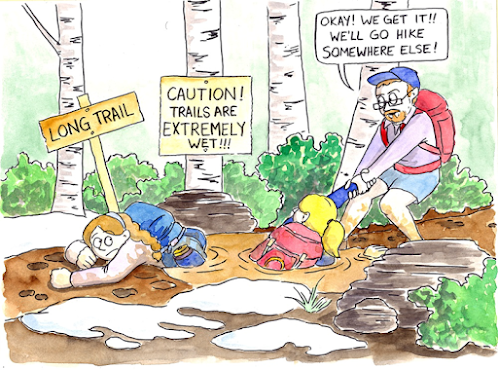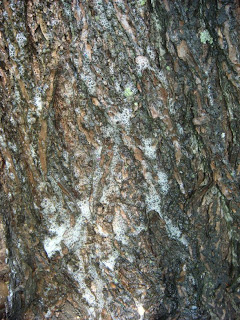Protect Vermont's Hiking and Biking Trails During Mud Season
FOR IMMEDIATE RELEASE: April 1, 2022
CONTACT:
Becca Washburn, VT Dept. of Forests, Parks and Recreation, becca.washburn@vermont.gov
Protect Vermont’s Hiking and Biking
Trails During Mud Season
Vermont – The
Vermont Department of Forests, Parks and Recreation (FPR) wants to remind the
public that it is mud season and many trails around the state are closed through
Memorial Day weekend. Mud season is the time period (typically the duration of
April and May), when hiking and biking trails are extremely wet and muddy due
to the combined effects of snow melt, thawing ground, and seasonal rain. We ask
the public to avoid muddy, soft trails, especially at high elevations, in order
to protect the trails, protect alpine vegetation, and leave trails in good
shape for the hiking and biking season.
“Trail
organizations and land managers, along with hundreds of dedicated volunteers, work
hard to keep the trails in good condition throughout the hiking and biking
season. We seek the public’s help in reducing mud-season damage done to the
trails, so that we may enjoy them for many seasons to come,” said Forests,
Parks, and Recreation Commissioner Michael Snyder.
“Mountain
bike trails, while not usually at high elevation, are extremely susceptible to
damage during mud season,” said Nick Bennette, Executive Director at the
Vermont Mountain Bike Association (VMBA). “If your tires leave a noticeable rut
in the trail, turn around and find a durable surface to ride elsewhere. If you
encounter a puddle, ride on the dry area of the trail or straight through if
there is none. Mountain bikers can show our commitment to being a community of responsible trail users by using
these simple guidelines and some common sense to protect our trails.”
In addition,
FPR asks the public to follow these guidelines:
· Official closures and trail conditions vary widely throughout the state. You can check
resources like Trailfinder.info, Green Mountain Club Visitor Center (802-244-7037), VMBA Trail
Conditions, or Trailforks.com to find out what trails are closed or open near you.
But to keep it simple: Avoid all wet and muddy trails during this time,
especially trails at high elevations (above 2,500’).
· Seek out durable surfaces to hike or bike on, like gravel roads, paved roads,
rail trails, and bike paths, as these are more resilient to mud season. If you
do encounter mud, go through it instead of around it. This will help protect
the fragile plants and soil along the edges of trails.
·
Avoid hiking in the alpine zone to protect rare and fragile vegetation.
It
takes careful stewardship to protect these environments so they can
continue to thrive. Foot traffic through the mud causes soil compaction and
erosion, which makes it harder for these plants to take root and survive in
their environments. Always stay on the trail and walk directly on the rocks
when hiking in the alpine zone to avoid trampling these fragile plants.
·
Local VMBA
Chapters often post signs regarding closures. Please respect these signs, and even if a trail
appears to be open, if you arrive and discover muddy conditions or notice your
bike tires are leaving ruts more than ½-inch deep, turn around and ride
elsewhere. Trail conditions can change rapidly during mud season, so please
don’t use the lack of a closure – either physical or online – to justify poor
judgement.
· Weather conditions will differ at higher elevations. It may be sunny and warm in town but windy, slippery,
snowy, and/or cold on the mountain. Check weather reports for your destination
and always be prepared with extra layers, traction, and a contingency plan.
· There are plenty of ways you CAN get outside! Ride rail trails or hike paved mountain roads like
the ones on Mt. Philo, Mount Ascutney, and the Mount Mansfield Toll Road.
Explore new parks and trail systems in your town. Try paddling, gravel biking,
birdwatching, fishing, or turkey hunting. Check out https://www.greenmountainclub.org/hiking/hikevt-mud-season-index/ for mud-season appropriate trails of all categories
and difficulties.
· If you encounter conditions you are not prepared for,
please turn around. It keeps you, and
the trails, safe.
Why is
Vermont so Muddy?
With our
long, cold winters, the ground freezes solid and takes several weeks of
above-freezing temperatures to thaw out. While the surface snow and ice melts,
the ground below is still solid, so water has nowhere to drain. Soils are even
more waterlogged because the trees are still without full sets of leaves, and
cannot absorb as much groundwater as they do later in the season. These
conditions will likely persist in many places, particularly at high elevations,
until Memorial Day.
The
Department of Forests, Parks and Recreation and partners thank trail users for
their cooperation in helping to maintain Vermont’s trails!
The Department of
Forests, Parks and Recreation (FPR) is responsible for the conservation and
management of Vermont’s forest resources, the operation and maintenance of the
State Park system, and the promotion and support of outdoor recreation for
Vermonters and our visitors. For more
information, visit www.fpr.vermont.gov


.jpg)
.jpg)
Comments
Post a Comment
Feel free to let us know what you think.